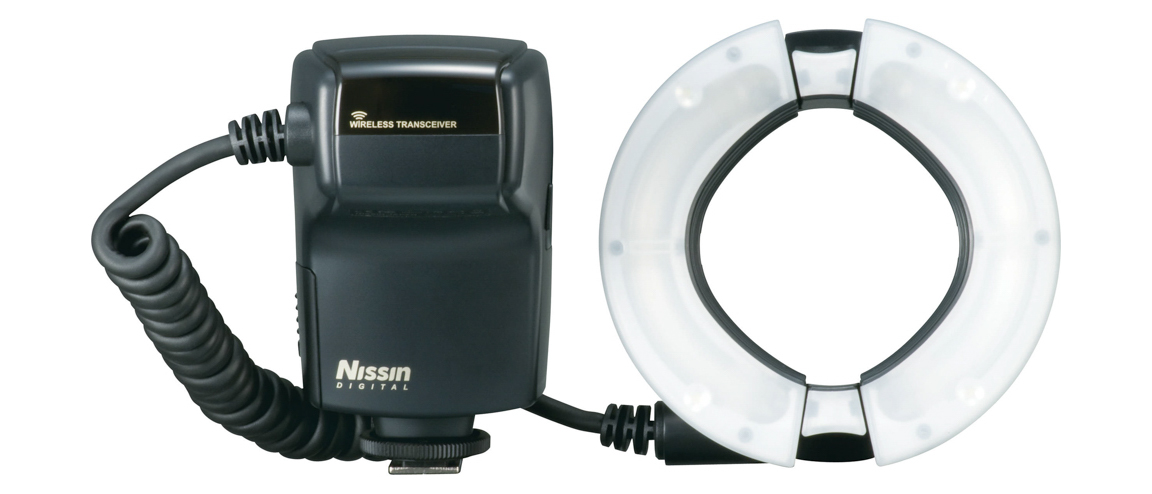Digital Camera World Verdict
Pros
- +
Superb specification
- +
Sensibly priced
- +
Great range of adapters provided as standard
Cons
- -
Occasionally under-exposes
- -
Controls are sometimes unresponsive
Why you can trust Digital Camera World
Nissin flashguns offer plenty of bang for your buck, and this ring flash continues the trend. An alternative to the macro ringflashes made by major manufacturers, this model allows the light from each of its sides to be controlled independently. It offers a guide number (GN) of 16m at ISO100, and is compatible with Nikon, Canon and Sony TTL metering algorithms, and provides support for wireless shooting by acting as a master to a number of slaves.
Nissin has generoursly thrown in six adapter rings for use with different lenses as standard - allowing you to attach to lenses with 52mm, 58mm, 62mm, 67mm, 72mm, or 77mm front filter threads. Adapter rings are available for purchase separately for 49mm, 55mm, and 82mm threads ($30/£25 each).
The USP is its Fine Macro function, which allows output to be adjusted from 1/128 to 1/1024 in 1/6 EV steps. In "normal" mode, the power adjusts in one-third stop steps, from full power down to 1/64 power.
Users of Nissin’s more conventional flash units should find the rear of the model familiar, with its colorful graphic user interface and simple four-way pad.
The unit itself is only a shade smaller than an entry-level flashgun, although the LCD screen, being only slightly larger than a postage stamp, could be bigger. Despite its all-plastic construction, the unit’s overall build quality is impressive, with a metal hotshoe at its base and no creaking under pressure or any noticeable weaker parts. The flash locks into position with a ridged locking wheel, and you can quickly switch control between the ring’s left and right section. Operation is straightforward enough, and much can be worked out without recourse to the manual.
Specifications

Dedication: Canon, Nikon or Sony
Gn, ISO 100 (m / ft): Gn 16 / 52
Manual Power Settings: 1/1 to 1/1024
Flash duration: 1/700 sec (Full power) - 1/30,000 sec (1/1024 power) when A and B tubes flash together, 1/300 sec (1/1 power) when A or B tube flashes individually
AF-assist beam: LED lamp
Wireless: Optical commander / slave, four channels / three groups
Other modes: HSS, rear curtain sync
Power: 4x AA batteries
Dimensions: Body - 115 x 65 x 85mm (4.5 x 2.6 x 3.3”); Ringflash - 120 x 134 x 41mm (4.7 x 5.3 x 1.6”)
Weight (excl batteries): 446g (16 oz)

There are some useful advanced features too. It provides X-terminal and DC input socket for an external power pack. It also features a USB port for firmware upgrades. Full master/slave wireless functions are available with four channels and three groups. Most usefully, the two flash units at either side of the ring can being independently adjustable for more three-dimensional-looking images.
Recycling times are excellent, and operation is essentially silent. The only sticking point is with responsiveness, with faster button presses sometimes not always registering.
You can’t beat ring flash for even, shadow-free illumination in macro shots, and it’s also great for fill-flash in portraits, where it can eliminate shadows, as well as create striking circular catchlights in the eyes. However, it’s relatively unwieldy compared with a regular flashgun.
Sample images





Verdict

A guide number of 16 at ISO 100 is enough poke for portraiture or macro photography, and we loved that the power is adjustable in precise 1/6 EV steps using the Fine Macro mode.
Switching modes is easy with the color LCD on the control unit, and this simple-to-use interface also makes light work of configuring the wireless TTL master and slave flash options. We did occasionally find the buttons were temperamentally unresposive
Performance doesn’t disappoint either, with the dual semi-circular flash tubes providing great light softness and neutrality. We did find some images were underexposed - but with the type of subjects you would usually shoot with this - taking a shot and then adjusting the flash output is often the best route to establishing exposure anyway.
Chris George has worked on Digital Camera World since its launch in 2017. He has been writing about photography, mobile phones, video making and technology for over 30 years – and has edited numerous magazines including PhotoPlus, N-Photo, Digital Camera, Video Camera, and Professional Photography.
His first serious camera was the iconic Olympus OM10, with which he won the title of Young Photographer of the Year - long before the advent of autofocus and memory cards. Today he uses a Nikon D800, a Fujifilm X-T1, a Sony A7, and his iPhone 15 Pro Max.
He has written about technology for countless publications and websites including The Sunday Times Magazine, The Daily Telegraph, Dorling Kindersley, What Cellphone, T3 and Techradar.


